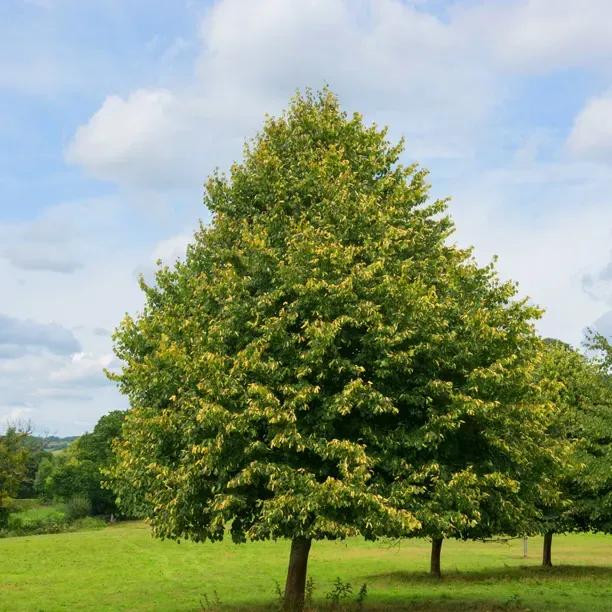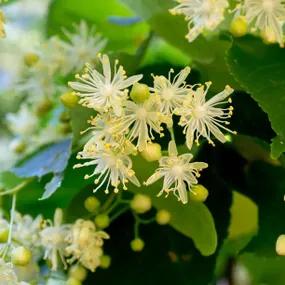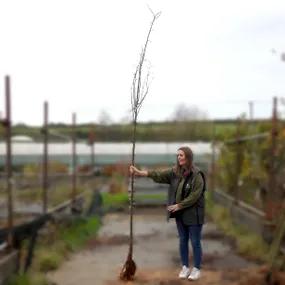Greenspire Lime / Linden, Large Trees
Honest Delivery Prices- Native. Tidy, teadrop shaped canopy.
- Excellent avenue tree.
- Sizes: Standards only.
- RHS Award of Garden Merit
- Max. Height: 15m
- Bareroot Delivery: Nov-Mar.
Recommended extras
Description
Tilia cordata Greenspire: Bareroot Lime / Linden Trees in Standard Sizes
Greenspire is a narrow variety of the native Small Leaved Lime with a teardrop-shaped canopy. A medium-sized, upright, neatly cone-headed tree that reliably maintains a single leading stem, perfect for large scale planting in urban areas or lining a driveway. It produces sweet-scented flowers in spring, adored by bees. The heart-shaped, glossy green leaves have a pale underside.
Like all limes, it is vigorous. It can reach a height of about 15-20 metres.
Browse our other Lime tree (Tilia) varieties or our full range of trees.
Delivery season: Lime trees are delivered bareroot during late autumn and winter, approximately November-March inclusive.
Choosing a size: Small trees are cheaper, easier to handle and more forgiving of less than ideal aftercare, so they are best for a big planting project. If instant impact is your priority, or if you are only buying a few plants for use in a place where it is convenient to water them well in their first year, then you may as well use bigger ones. All our bareroot trees are measured by their height in centimetres above the ground (the roots aren't measured).
Features:
- Height: 15-20m
- Soil: Any well drained, mildly acidic to alkaline soil.
- Use: Wide avenues, parks, large gardens, near the coast
- Colour: Yellow-cream flowers in June-July, strong aroma
- Responds well to hard pruning
- RHS Award of Garden Merit
- Bareroot delivery only: November-March
Growing Greenspire Lime Trees
Extremely tough and undemanding, they thrive best on alkaline soils, but mildly acidic soil is fine. They are happy in heavy, compacted clay with paving around them: a town planner's best friend.
They tolerate partial shade well, and are recommended for exposed locations; they won't grow right on the beach, but tolerate salt winds. When established, they are drought tolerant.
Limes respond very well to pruning, and are perfect for pollarding.
Planting Instructions
Notes on planting Greenspire Linden trees:
Greenspire Linden trees will grow well any fertile soil and tolerate partial shade. They are suitable for exposed locations. Like other limes, these are very pollution resistant trees.
They will not grow well if the site is very wet or if the soil is poor and dry.
Prepare your site before planting:
It is good to dig over the site where you plant a tree several months in advance. Kill the weeds first: for tough weeds like nettles, brambles and ground elder, you will usually need a weed-killer to get rid of them. When you dig the soil over, remove stones and other rubbish and mix in well rotted compost or manure down to the depth of about 2 spades.
Watch our video on how to plant a tree for full instructions.
Remember to water establishing trees during dry weather for at least a year after planting.
Tree Planting accessories:
Prepare your site for planting by killing the weeds and grass.
You can buy a tree planting pack with a wooden stake & rubber tie to support the tree and a mulch mat with pegs to protect the soil around the base of your tree from weeds and drying out.
We suggest that you use mycorrhizal "friendly fungi" on the roots of all newly planted large trees: if your soil quality is poor, we strongly recommend it.
You can also improve your soil with bonemeal organic fertiliser.
Did You Know?
This tree was bred from the cultivar T. cordata Euclid and an unknown German linden at Princeton Nurseries in Boston and released in 1961.
Pretty much all the Tilia species grown in the UK are on the RHS Plants for Pollinators list apart from (at the time of writing) T. cordata: this has to be an oversight.
Standard trees are measured by their girth in centimetres 1 metre above ground level: their trunk's waist measurement. Unlike sapling trees and hedge plants, standards aren't measured by their height, which will vary quite a bit both between and within species.
So, a 6/8cm standard tree has a trunk with a circumference of 6-8cm and an 8/10 standard has a trunk 8-10cm around. This measurement makes no difference to the tree's final height.
On average, standard trees are 2-3.5 metres tall when they arrive, but we cannot tell you precisely how tall your trees will be before we deliver them.




